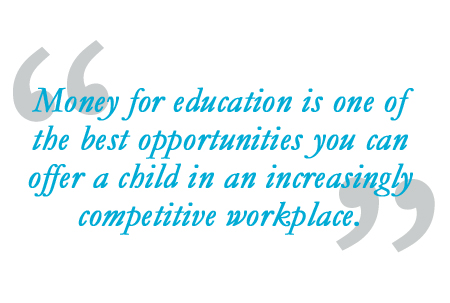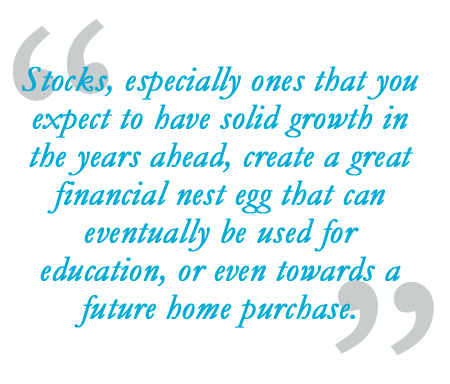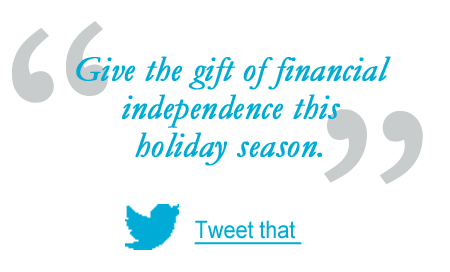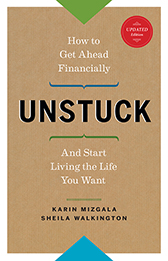By Noel D’Souza, P.Eng, CFP®

The holidays are a time of giving, but many Canadians are tired of spending money on “stuff” that is soon forgotten by kids and adults alike. As a result, there is growing interest in gifts that are more meaningful.
The gift of a shared experience—dinner, movies, trips, concerts or sporting events—has gained popularity over the last few years. Shared activities create memories that are priceless and last long after the event is over. And that’s what many people want to give; gifts with lasting impact.
But if impact is what you’re after, consider gifts that go beyond good memories; consider simple ways to add to your children’s or grandchildren’s financial security.
Here are some options that you probably won’t find on anybody’s wish list, but may be the best gift they receive.
Dividend Reinvestment Plans (DRIPS)
Okay, I concede that Dividend Reinvestment Plan, sounds pretty dry, but imagine sitting in the movie theatre with your children or grandchildren, eating popcorn and waiting for the next Disney blockbuster to start, and reminding them that they are owners in the Walt Disney Company; that when Disney makes money, they get paid dividends. Lots of kids will find that pretty cool, and when they are older and that investment has grown, they will think you’re pretty cool.
So how does a DRIP work? A Dividend Reinvestment Plan works as its acronym suggests: you purchase shares in the company, and the dividends you receive are reinvested—or dripped—back into the purchase of more stock. What is unique is that the drip dividend is able to purchase a percentage of a share. For example, if a stock trades at $10 and pays a dividend of $1, investors on the drip plan will have the $1 reinvested as one tenth of a share. This allows for slow but steady growth over time. Brokers also offer commission and fee-free reinvestment of dividends, but only whole (not fractional), share purchases.
DRIP plans are company operated, so there are no commissions or broker fees on the reinvested dividends. Some DRIPS even offer the purchase of additional shares at a 1-10% discount and with no fees. The plans are usually flexible, allowing investors to make quite small or quite large contributions, making it a good choice for investors at all levels. For a closer look at DRIPS you can read John Heinzl’s article in The Globe and Mail.
Not only are there financial benefits long term, there is also an opportunity to teach children about how the stock market works. To help kids feel a connection to their investments, you can choose one of several solid companies, with kid recognition, that offer DRIPS.
Set Up and Contribute to a Registered Education Savings Plan (RESP)
You’ve no doubt heard people talk about the high cost of education, imagine what those costs will be in 5, 10 or 15 years. Money for education is one of the best opportunities you can offer a child in an increasingly competitive workplace.
 But money for education does more than support education goals; it also ensures that reaching those goals doesn’t come with the price tag of huge student loan debt. Graduates with debt are more likely to feel financial pressure to accept a job for what it pays, instead of what it can offer in the way of long term career opportunity.
But money for education does more than support education goals; it also ensures that reaching those goals doesn’t come with the price tag of huge student loan debt. Graduates with debt are more likely to feel financial pressure to accept a job for what it pays, instead of what it can offer in the way of long term career opportunity.
There are many ways to invest and save money for school, but a Registered Education Savings Plan offers what other methods don’t – the opportunity for Canada Education Savings Grant (CESG) money from the federal government. These grants match 20% of eligible RESP contributions up to $500 a year, to a maximum lifetime grant of $7,200 per child. Depending on your income, you may also qualify for additional grants. There are also possibilities for provincial education grants depending upon where you live. Funds within an RESP may be invested in stocks, bonds, mutual funds or GICs.
Money contributed to an RESP is not tax deductible, but earnings are tax deferred until the money is withdrawn, and at that time they are taxed at your child’s lower tax rate. Your child or grandchild is able to access this money while enrolled in university, college or another qualifying education program. An RESP can stay open for up to 36 years (up to 40 years for beneficiaries eligible for the disability tax credit).
Giving an RESP contribution as a gift is a great chance to show kids that you believe in them and their future. The older the child, the more you can ask them about the sort of work that looks appealing to them. You can also share stories about your own education, and about the education challenges that other family members may have overcome in the past.
Re-title Your Stocks
Instead of investing money in DRIPs or RESPs, you could make a gift of stock you already own. Stocks, especially ones that you expect to have solid growth in the years ahead, create  a great financial nest egg that can eventually be used for education, or even towards a future home purchase.
a great financial nest egg that can eventually be used for education, or even towards a future home purchase.
There are, however, a few things to understand about gifting stock.
There will be immediate tax consequences. When you gift shares, Canada Revenue Agency (CRA) assumes fair market value on the date of the gift, and taxes you on any capital gain, as if you had sold the shares.
CRA also has income attribution rules that have been created to deter people from re-titling shares for the purpose of avoiding taxes. As long as the recipient of the stocks is under 18 years-of-age, any interest or dividends earned on the shares will be attributed to your income. Once the recipient is over 18, all income attribution will revert to him or her. When the recipient eventually sells the shares, the fair market value that was determined on the day they were gifted, becomes the base point to calculate any capital gains.
Because of the tax implications, it is advised that you consult a financial professional before re-titling stock, to ensure that it is done in the most financially advantageous way for your personal situation.
Set Up and Contribute to a Savings Account
This final idea comes with the benefit of also being a shared experience. If your child or grandchild has yet to open a bank account you can make a day of it.
 Start by talking about the purpose of a bank account. Explain about savings and chequing accounts. All of this is new to kids. Many kids may have never even been inside a bank, as most parents likely bank online.
Start by talking about the purpose of a bank account. Explain about savings and chequing accounts. All of this is new to kids. Many kids may have never even been inside a bank, as most parents likely bank online.
Take them to the bank and introduce them to a customer service representative. Let your child handle the money. Explain how this new bank account number is unique and theirs alone. It is also a good idea to choose paper bank statements that will be mailed to your child. Kids enjoy getting mail and you can look at the statement together. If you would prefer not to receive paper statements, make a habit of reviewing the account together online. Your child will see what went in and out of the account and how much interest was earned. Developing an interest in money management is a priceless gift.
Give them the gift of example
Whichever of these ideas appeals to you, you can couple it with being a positive money role model. Talk positively about money in general, but talk about it as a tool not as an end in itself.
Tell your kids or grandkids about something you saved for as a child. Ask them about something they are saving for. If you have given them some sort of investment, show them when it has grown, and explain why it might temporarily have gone down. Tell them about things you do to plan for your future.
Too many people grow up with the idea that talking about money is taboo. Being able to talk freely and positively about money is a wonderful gift for anyone.


